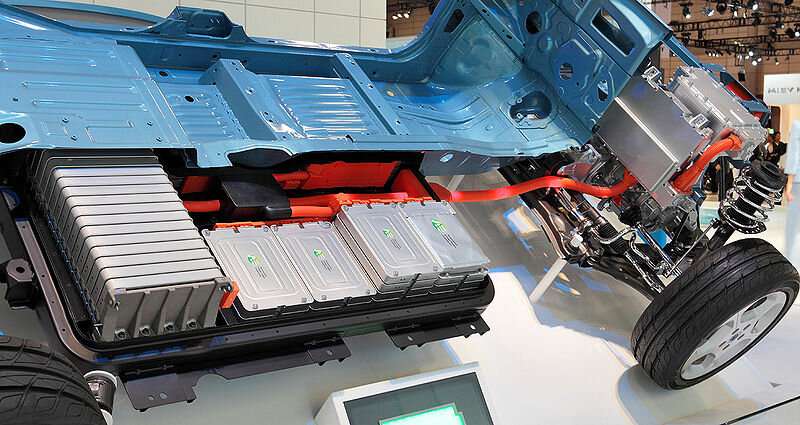Towards efficient lithium-air batteries with solution plasma-based synthesis of perovskite hydroxide catalysts

With global warming on the rise, it has become imperative to reduce fossil fuel dependency and switch to alternate green energy sources. The development of electric vehicles is a move towards this direction. However, electric vehicles require high energy-density batteries for their functioning, and conventional lithium-ion batteries are not up to the task. Theoretically, lithium-air batteries provide a higher energy density than lithium-ion batteries. However, before they can be put to practical use, these batteries need to be made energy efficient, their cycle characteristics must be enhanced, and the overpotential needed to charge/discharge the oxygen redox reaction must be reduced.
To address these issues, a suitable catalyst is needed to accelerate the oxygen evolution reaction (OER) inside the battery. The OER is an extremely important chemical reaction involved in water splitting for improving the performance of storage batteries. Rare and expensive noble metal oxides such as ruthenium(IV) oxide (RuO2) and iridium(IV) oxide (IrO2) have typically been used as catalysts to expedite the OER of metal-air batteries. More affordable catalytic materials include transition metals, such as perovskite-type oxides and hydroxides, which are known to be highly active for the OER. CoSn(OH)6 (CSO) is one such perovskite-type hydroxide that is known to be a promising OER catalyst. However, current methods of synthesizing CSO are slow (requiring over 12 hours) and require multiple steps.
In a recent breakthrough, a research team from Shibaura Institute of Technology in Japan, led by Prof. Takahiro Ishizaki along with Masaki Narahara and Dr. Sangwoo Chae, managed to synthesize CSO in just 20 minutes using only a single step. To achieve this remarkable feat, the team used a solution plasma process, a cutting-edge method for material synthesis in a nonthermal reaction field. Their research was published in Sustainable Energy & Fuels on 17 April 2023.
The team used X-ray diffractometry to show that highly crystalline CSO could be synthesized from a precursor solution by adjusting the pH to values greater than 10 to 12. Using a transmission electron microscope, they further noticed that the CSO crystals were cube-shaped, with sizes of about 100-300 nm. The team also used X-ray photoelectron spectroscopy to investigate the composition and binding sites of CSO crystals and found Cobalt (Co) in a divalent and Tin (Sn) in a tetravalent state within the compound.
Finally, the team used an electrochemical method to look at the properties of CSO as a catalyst for OER. They observed that synthesized CSO had an overpotential of 350 mV at a current density of 10 mA cm−2.
“CSO synthesized at pH12 had the best catalytic property among all samples synthesized. In fact, this sample had slightly better catalytic properties than that of even commercial-grade RuO2,” highlights Prof. Ishizaki. This was confirmed when the pH 12 sample was shown to have the lowest potential, specifically 104 mV lower than that of commercially available RuO2 vs. reversible hydrogen electrode at 10 mA cm−2.
Overall, this study describes, for the first time, an easy and efficient process for synthesizing CSO. This process makes CSO practically effective for use in lithium-air batteries and opens a new avenue towards the realization of next-generation electric batteries.
“The synthesized CSO showed superior electrocatalytic properties for OER. We hope that the perovskite-type CSO materials will be applied to energy devices and will contribute to the high functionalization of electric vehicles,” Prof. Ishizaki concludes. “This, in turn, will bring us one step closer towards achieving carbon neutrality by enabling a new energy system independent of fossil fuels.”
More information:
Masaki Narahara et al, Solution plasma synthesis of perovskite hydroxide CoSn(OH)6 nanocube electrocatalysts toward the oxygen evolution reaction, Sustainable Energy & Fuels (2023). DOI: 10.1039/D3SE00221G
Provided by
Shibaura Institute of Technology
Citation:
Towards efficient lithium-air batteries with solution plasma-based synthesis of perovskite hydroxide catalysts (2023, June 26)
retrieved 26 June 2023
from https://techxplore.com/news/2023-06-efficient-lithium-air-batteries-solution-plasma-based.html
This document is subject to copyright. Apart from any fair dealing for the purpose of private study or research, no
part may be reproduced without the written permission. The content is provided for information purposes only.
For all the latest Technology News Click Here
For the latest news and updates, follow us on Google News.

